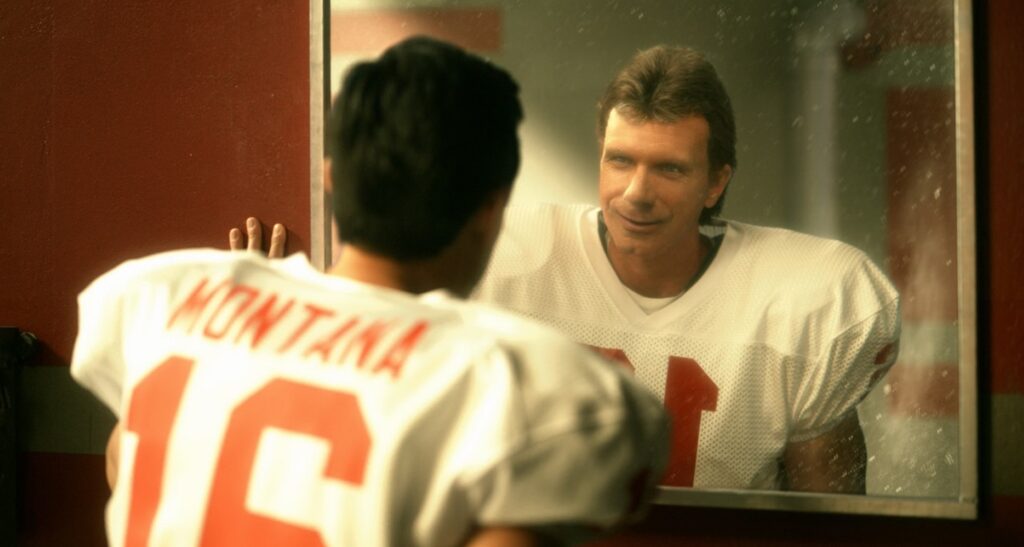Uses its proprietary software to shave decades off Joe Montana to promote the rebooted TV series Quantum Leap.


Most of us, if given the chance, would like to look much younger than we are. We would smooth out wrinkles and erase age spots, and even restore our original hair in terms of color, texture, and volume. In real life, creams, chemicals, and procedures can only do so much. But in the VFX world, almost anything is possible, even turning back time—and in rare instances, winding it forward.
Digital Domain has been advancing such techniques ever since its work on the film The Curious Case of Benjamin Button (2008), about a man who starts aging backward. For a better part of the movie, the older-looking version of the main character was digital, built by Digital Domain; the younger version is played by actor Brad Pitt. Since then, Digital Domain has continued to advance this capability in a number of films and other projects involving high-profile people, evening bringing some, like coach Vince Lombardi, back to life.
Most recently, the Digital Domain team created a young version of legendary quarterback Joe Montana, using Charlatan, its proprietary face-swapping tool powered by machine learning, in conjunction with some digital artistry. The work was done for an ad for NBCUniversal’s new TV revival Quantum Leap, about a time-traveling/body-swapping physicist who “leaps” randomly into the bodies of unsuspecting people in need of help. The appearance of Montana in the stand-alone commercial was especially meant to pique the interest of the audience to which it was shown—namely football fans, as it aired during NBC Sunday Night Football. (There are no plans to have the Pro Football Hall of Famer star in an episode.)
To spark wide interest in the show, NBCUniversal commissioned a series of trailers, including the one of Montana in his prime.
In just four weeks, the studio was able to digitally create a version of Montana from the 1980s as the quarterback of the San Francisco 49ers. They did so by applying a photorealistic CG version of the athlete’s face onto the body of a live stand-in with a similar facial structure to Montana’s. As is typical in the TV show, the “leaping” scientist catches a glimpse of himself after assuming the identity of the unsuspecting person he is there to help, showing audiences the temporary identity he assumes for the episode. (As the show unfolds, the audience and a project lead from present day who can communicate with Seong see the scientist, Dr. Ben Seong (played by Raymond Lee) in his actual form in camera, while those rooted in the period see the person into whom the physicist leaps.)
Immediately following each series’ leap, Lee and the person who is the focus of the episode, mimic each other from opposite sides of an open frame, illustrating the premise of the show. The spot does so as well, with Lee on one side of the frame and the Montana stand-in on the other. In post, the studio artists added a layer of dirt and grime to further sell the effect that Lee is looking into an actual mirror.
After that work was completed, the director and team met with now 66-year-old Montana, who then was filmed performing the same actions and facial movements that his stand-in did They also took photos for a photogrammetric reconstruction of his head, which was used for head tracking and 2.5D projections.
Meanwhile, the group skimmed through a range of archival footage of Montana from 1984 through 1990, and then ran all the data—past and present—through Charlatan, where a machine-learning model was generated of Montana’s face as it looks today. Next, the reconstruction was placed over the live-action footage of the stand-in. Then, the de-aging process began, seamlessly integrating the new face with the footage. To complete the model, artists re-created the hair and made other small tweaks.
Even though this process took a few weeks, it was still much easier, faster, less costly, and the results more authentic than it would have been had the artists chose a more traditional route of building a CG model of Montana’s face using traditional methods.
“Having access to Charlatan means that we can do things that simply couldn’t have been done before—at least not at this speed or level of quality,” said Matt Smith, Charlatan department supervisor for Digital Domain. “It still requires a roster of incredibly talented artists to pull off something like de-aging Joe Montana, but Charlatan gives creatives options that just didn’t exist a few years ago.”






